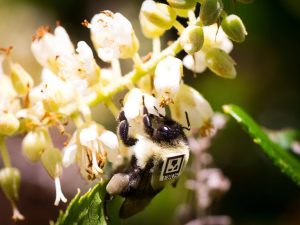QR Codes...on Bumblebees?
Posted on by Chad DormanOften we read about QR codes being used to sell or market goods to consumers, but here is a new use – bumblebee research. Researchers have created a new way to study the buzzing bees – attach QR codes to their backs. Using a special vacuum, the bees are collected and put in a refrigerator to chill thereby rendering them immobilized. Once immobilized, very small, simplified QR codes are superglued to their backs. Previously researchers would stand over colonies, tracking the behavior of individual bees. Its hard to believe they would not confuse the bees as they all look similar. The system, called BEEtag, allows cameras to automatically monitor hundreds of bees at all times, allowing reseachers to learn about their personalities and interactions. Bumblebees may all look alike, but research using QR codes has shown that they actually have lots of personality. Some are more active than others, some forage all day, and other remain more in the nest. With bee populations on the decline recently, this information is certainly important and the implications for other similar research methods are aplenty. For example, it has been suggested that pesticides may have to go through testing with BEEtag before receiving regulatory approval. Assistant Professor Stacey Combes’ research with former Harvard graduate student James Crall on this was recently published in Nature Communications. Great to see people using QR codes to help our insect friends.
wired.com/story/why-these-bumblebees-are-wearing-itty-bitty-qr-codes/ (Image Credit)
biology.ucdavis.edu/news/stacey-combes-and-why-these-bumblebees-are-wearing-itty-bitty-qr-codes-wired


